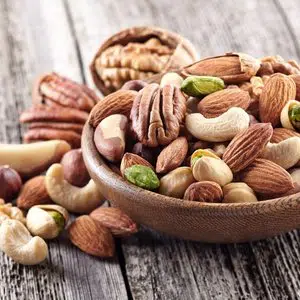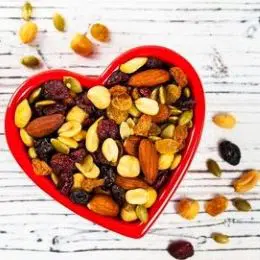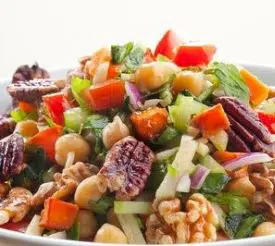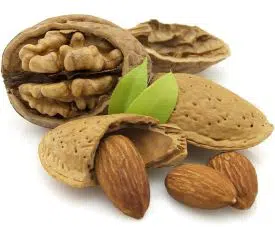
Nuts for Heart Health: What’s the Best Advice on How They Can Help?
Inside: What are the best nuts for heart health? Can you really include healthy nuts for weight loss? These are a few of the questions people ask as they try to make sense of conflicting fears and headlines on nuts in healthy eating habits.
Headline-making studies suggest that including nuts in an overall healthy diet could protect against not only heart disease, but perhaps cancer and diabetes, too. That makes it confusing when you see websites and diet books that claim to hold the key to disease-prevention and call for limiting or avoiding nuts.
So what does the big picture of current research say about nuts and health?
KEY TAKE-AWAY POINTS
♦ For cardiovascular health, evidence is strongest supporting a protective influence of nuts on blood lipids and on blood vessel function. It may also involve factors such as antioxidant and anti-inflammatory defenses, blood pressure, and the gut microbiome.
♦ What about weight? Nuts were once deemed “fattening” because they are concentrated sources of calories. Research now shows several reasons that may explain findings that eating nuts frequently does not lead to weight gain or an unhealthy weight.
♦ Additional benefits of including nuts as part of a plant-focused eating pattern may include reduced cancer risk and improved heart health among people with diabetes.
♦ How nuts are used plays a role in the health benefits they provide. Choose nuts as replacements for less healthy choices and to enhance the flavor and nutrition of other nutrient-rich foods in a plant-focused diet.
Nuts and Health: Does A Handful a Day Keep the Doctor Away?
Many studies identify nuts as valuable contributors to a plant-focused diet pattern.
People who ate more nuts had mortality rates nearly 20% lower during follow-up periods ranging from 5 to 30 years in an analysis of prospective studies that included more than 800,000 adults. There’s no need to go nutty about nut consumption, however.
- The greatest difference in mortality rates was between those who consumed any nuts weekly compared to those who ate none.
- No further reduction in mortality rates is seen above 15 to 20 grams of nuts per day. That’s the equivalent of having an ounce of nuts (about one handful) four or five days a week.
- Both tree nuts (including almonds, hazelnuts, pecans, pine nuts, pistachios, and walnuts) and peanuts show similar links to lower all-cause mortality rates. Peanut butter consumption is associated with smaller, if any, reduction in overall mortality rates. However, people in these large population studies who eat nuts primarily as peanut butter tend to differ from other nut consumers in several lifestyle factors that affect health, which could explain the different associations.
Nuts for Heart Health: Are They Terrific or Taboo?

- Evidence is rated even stronger from observational studies that show nearly 30% lower CVD mortality tied to an ounce of nuts consumed per day.
- These lower mortality rates are consistent regardless of whether follow-up time was shorter or longer than 9 to 15 years.
- CVD and CHD mortality decrease with each increase in nut consumption from no intake to amounts equivalent to eating an ounce four or five days per week. Amounts beyond that don’t show additional reduction in mortality rates. (However, it’s noteworthy that the studies weren’t set up to capture associations with much higher intake because it occurs so seldom in the populations studied.)
What’s behind the association of nuts and heart health?
(1) Reduced atherosclerosis-promoting lipids
Nuts’ link with reduced levels of LDL (“bad”) cholesterol is an important element in the heart health benefits. An analysis of 38 randomized controlled trials shows LDL levels reduced 4.2 mg/dl for each ounce of nuts consumed daily. And in this case, more may be better. Two or more servings per day can reduce LDL even further. In these controlled trials, nuts also reduced levels of apoB, especially among people with type 2 diabetes. (This apoB protein is another indicator of cardiovascular risk. Higher numbers indicate greater number of atherogenic particles — LDL, VLDL and IDL.)
LDL-lowering is no surprise, since nuts are such important sources of unsaturated fat. But the degree of LDL-lowering is often greater than expected based on nuts’ fat content alone. Some evidence suggests that the additional cholesterol-lowering may come from phytosterols in nuts. Yet LDL-lowering recommendations suggest a target of two grams of phytosterols daily (usually requiring specially fortified products). A one-and-a-half-ounce serving of nuts supplies less than 6% of that target.
(2) Vascular health support
Blood vessel function is a key element of cardiovascular health. When cells lining the inside of blood vessels lose control of when and how much blood vessels relax or constrict, this can lead to elevated blood pressure, inflammation and clot formation. Several human intervention trials show that after several weeks of consuming about 1 ½ to 2 ounces of nuts daily, tests of blood vessel flow and ability to dilate properly improved.
- Nuts provide L-arginine, an amino acid. Cells lining blood vessels use L-arginine to produce nitric oxide, a compound that triggers blood vessels to relax and let blood flow more easily.
- Polyphenol compounds seem to reduce artery stiffness and enhance endothelial cell production of nitric oxide, which may also explain how nuts are among foods beneficial for vascular health.
(3) Potential defender
- A boost to heart health that won’t show up in blood cholesterol levels could come from antioxidants in nuts. Research suggests that oxidized LDL particles are the most damaging to blood vessels. Almonds, hazelnuts and pine nuts are the nuts you’ll see labeled as rich in vitamin E, because they contain high amounts of alpha-tocopherol. That’s the form on which dietary recommendations are based. But gamma-tocopherol, and other tocopherol and tocotrienol forms of vitamin E, also demonstrate antioxidant effects in cell and animal studies. Pecans, pistachios and walnuts all supply significant gamma-tocopherol.
- Laboratory studies with flavonoids and other phenolic phytochemicals found in nuts suggest potential to support the body’s own (endogenous) antioxidant defenses. More research is needed to understand if such effects occur with human consumption of these compounds.
- Other research suggests that nuts’ association with heart health could stem from potential to inhibit chronic low-grade inflammation. Results of human research — observational population studies that follow people for many years and controlled intervention trials — have been inconsistent, however. Characteristics of the people participating in a study and details of an intervention may affect the ability to detect anti-inflammatory effects, and some evidence suggests that effects may be more apparent in trials that last at least 12 weeks.
(4) Better blood pressure? Unclear.
- Nut consumption is consistently linked with lower risk of hypertension in observational studies that follow large population groups over time. This makes sense, since nuts are good sources of magnesium. Part of the benefits of magnesium for heart health seem to include blood pressure control. (You may hear nuts touted as a good source of potassium, another helper for blood pressure. But although nuts provide some potassium, none include enough to be considered a good source.)
- Controlled intervention trials don’t show effects of nuts on hypertension, however. An analysis of 17 randomized controlled trials found no effect on systolic or diastolic blood pressure. It’s possible that the connection of nuts and hypertension in observational studies is due to some other factor in the diet or lifestyle of people who eat more nuts. Or perhaps controlled trials need to dig deeper to find amount, time duration, or individual characteristics in which nuts can help manage blood pressure.
- In “real life”, your food choices influence health based on what you eat and what you don’t eat. When you choose nuts, what are they replacing? For example, even if nuts don’t directly reduce blood pressure, if you choose them instead of a high-sodium, ultra-processed snack food, then your choice of nuts is likely to help keep a healthy blood pressure.
Can Nuts Protect Against Risk of Diabetes and Diabetes’ Risks?
Earlier observational population studies suggested an association of nut consumption with lower risk of developing type 2 diabetes. But so far, overall results of this research does not show an association of nut consumption with risk.
However, cardiovascular disease is a major cause of death among people with diabetes. And these studies link nut consumption to decreased cardiovascular mortality and all-cause mortality among people with type 2 diabetes.
Some randomized controlled trials lasting 3 months to 1 year have shown decreased A1C (a marker of longer-term blood sugar control) or decreased fasting insulin among people with type 2 diabetes or prediabetes.
How Do Nuts Fit in a Diet to Reduce Cancer Risk?

- Observational population studies link higher nut consumption with lower overall cancer risk compared to people who don’t eat nuts. When limited to prospective cohort studies (the observational studies that provide strongest evidence), analysis of 33 cohorts shows 10 percent lower overall cancer risk among those with highest consumption. In these studies, “high” consumption typically averages an ounce or less per day. And analysis shows modest reductions in risk with smaller amounts.
- Laboratory studies with phytochemicals found in nuts show several mechanisms that could inhibit cancer development. For example, in cell and animal studies, these compounds influence gene expression in ways that decrease growth and stimulate self-destruction of cancer cells.
- Greatest evidence for nuts and cancer risk so far is available from studies involving walnuts and the phytochemicals they contain. Some protection against inflammation and cancer may involve prebiotic effects on the gut microbiome. For example, bacteria in the colon convert ellagitannins and ellagic acid (found in walnuts) to compounds called urolithins that may have protective effects within the colon and after they are absorbed out of the digestive tract.
Overall analysis by the American Institute for Cancer Research classifies research on nuts and cancer risk too limited to draw any conclusions about nuts and cancer risk at this time. But it’s clear that nuts can fit comfortably — and add flavor — to the overall eating habits that reduce cancer risk.
Are Nuts Good for Weight Loss? New Research Challenges Old Fears

But fear of the very real health risks of weight gain and obesity are not a good reason to avoid nuts.
- Large population studies show that people who eat nuts regularly are less likely to have overweight or obesity than people who never or rarely eat nuts. Even after studies statistically adjust for factors like physical activity, smoking and other dietary choices, this association with healthier weight tends to hold up.
- In some cases, this could reflect “reverse causality” – people who are leaner may be less afraid of nuts’ calorie load than people who are already carrying extra body fat. However, other types of studies show that consuming nuts does not hurt, and may even help, weight loss and weight maintenance efforts.
- Increased consumption of nuts over time was associated with lower risk of having obesity and less weight gain (regardless of baseline weight). This was seen in observational studies over four-year periods and over 20 to 24 years of follow-up.
- In controlled clinical trials, even without instructions to substitute nuts as replacement for some other food, including nuts does not lead to weight gain or increased waist size.
- Limited research shows that nuts don’t provide as many calories to the body as would be predicted based on standard calculations.
- Nuts may promote satiety, particularly compared to refined grains, sweets, chips and other common snack foods. Emerging evidence suggests this may be due to fiber and fat content, and may involve effects on the gut microbiome.
Is It Which Nuts Are Best? Or How to Best Use Nuts?

Image credit: dionisvera at 123rf.com – 6544763
Although nuts share many similar nutrients and phytochemicals, nuts differ from each other, too.
Many studies on nuts – especially controlled intervention trials – focus on a single nut. Results of research conducted on one nut can’t be assumed to apply to other nuts. But it does not indicate that the specific nut tested is unique in providing beneficial effects seen.
- Almonds and hazelnuts are highest in the alpha-tocopherol form of antioxidant vitamin E. And pecans, pistachios and walnuts are highest in the gamma-tocopherol form, which may act in somewhat separate roles.
- All nuts contribute to bolster magnesium intake. Almonds, cashews, and peanuts are top sources.
- Walnuts are relatively unique content in their level of ellagitannin phytochemicals that may support a healthy gut microbiome.
- Some research suggests that at least half of the phytochemicals (natural plant compounds) in nuts are lost when the soft skin called the pellicle is removed. Walnuts are almost always eaten with this pellicle attached, but almonds and peanuts, for example, may or may not be.
- Evidence on support for a healthy weight and avoiding weight gain is consistent among all nuts studied, including peanuts. And analysis of studies of tree nuts effects on LDL cholesterol shows no differences between nuts.
How nuts benefit health likely depends on how you use them within overall eating habits. Click To Tweet
In the U.S., nuts are mostly consumed as snacks, and when consumed as ingredients in recipes, it’s primarily in candy, bakery and cookies. Although the nutrients and types of fat in nuts are healthful, when we consume them in foods that are loaded with sugar, unhealthy fats and excess calories, the potential benefits of nuts may be undermined. When we simply add nuts’ concentrated calories to a diet that already includes more calories than we burn, that could make weight control more difficult. Since overweight increases risk of heart disease, cancer and type 2 diabetes, that would be a significant negative effect.
When “out of hand” nut consumption (which would not include nuts consumed in candy and bakery) was specified, higher consumption in U.S. adults was linked adults was linked with higher diet quality (including lower sodium intake and higher fiber and unsaturated fat). Even modest consumption of nuts in this form was associated with lower levels of insulin and CRP (a marker of inflammation) compared to people who did not eat nuts Although only cross-sectional research, this suggests how nuts are used may be an important nuance in the interpretation of inconsistencies in population studies on nuts and health.
Here are five examples of ways to add nuts by easy swaps, ideally for less nutritious foods:
- Try toasted nuts in salads as replacements for bacon or croutons.
- Add nuts’ crunch and flavor to stir-fried or steamed vegetables.
- Sprinkle nuts on pasta or rice dishes. If you tend to choose excessive portions of these grain products, cut your portion a bit. With the added nuts, you’ll end up with a nutrient-rich dish that’s filling and satisfying dish.
- Use nuts to provide more protein at breakfast. They’re delicious on cold or hot cereal and stirred into yogurt. Calories won’t be excessive if you keep your cereal portion moderate and you avoid pre-sweetened, high-sugar yogurt. If your breakfast is a grab-and-go, a handful of nuts adds nutritional balance to your fruit and other choices.
- Nuts make a tasty snack that many find seems to provide longer-lasting energy than sweets, chips or crackers. Scoop out one handful into a small dish (not a cereal bowl).
How Eating Habits Can Include Nuts for Heart Health: Doable Tips
With all these potential positive effects on health that can come from including nuts among your other healthy choices daily, or at least several days a week, don’t let a “health halo” lead you astray.
Unsalted nuts are extremely low in sodium, but 1.5 ounces of salted nuts are as high in sodium as a small bag of potato chips.
- Nuts are nutrient-rich and a great addition as part of a healthy diet. That doesn’t refer to chocolate nut spreads that are loaded with added sugars and unhealthy added fat, making them more dessert than dietary staple.
- If you are looking for ways to boost calories to help you gain weight or meet your needs as you ramp up your exercise, then nuts are an excellent choice. They provide concentrated calories in a food that is far more nutritious than people get when they boost calories with huge bowls of ice cream or large amounts of sugar-laden drinks. However, if you aren’t trying to gain weight, make sure that you keep nut portions modest and that you substitute them for other foods.
Bottom Line on Nuts for Heart Health
Pulling together results of research from large observational studies, laboratory studies, and human intervention trials, evidence is good that nuts are well worth including in healthy, plant-focused eating habits. Although more research is needed, two things are clear: As long as you eat mindfully, aware of portions and hunger cues, fear of weight gain need not keep you from the many benefits nuts bring to the table. And since nuts differ in nutrients and flavor, including a variety of nuts is a strategy that’s smart – as well as delicious!
If you find this info helpful for putting what you see in headlines into the big picture, please share it on social media… or forward via email to a friend or colleague.
For more on research about nuts and health, as well as recipes using nuts, check:
- The International Tree Nut Council and
- The Foods that Fight Cancer section of the American Institute for Cancer Research (AICR) website.
For more tips on using nuts and links to recipes, check the websites of boards or commissions devoted to individual types of nuts, such as:
Amba V, Murphy G, Etemadi A, Wang S, Abnet CC, Hashemian M. Nut and Peanut Butter Consumption and Mortality in the National Institutes of Health-AARP Diet and Health Study. Nutrients. 2019; 11(7):1508.
Aune D. Plant Foods, Antioxidant Biomarkers, and the Risk of Cardiovascular Disease, Cancer, and Mortality: A Review of the Evidence. Adv Nutr. 2019 Nov 1;10(Suppl_4):S404-S421.
Aune D, Keum N, Giovannucci E et al. Nut consumption and risk of cardiovascular disease, total cancer, all-cause and cause-specific mortality: a systematic review and dose-response meta-analysis of prospective studies. BMC Med. 2016 Dec 5;14(1):207.
Becerra-Tomás N, Paz-Graniel I, W C Kendall C, et al. Nut consumption and incidence of cardiovascular diseases and cardiovascular disease mortality: a meta-analysis of prospective cohort studies. Nutr Rev. 2019 Oct 1;77(10):691-709. doi: 10.1093/nutrit/nuz042.
Del Gobbo LC, Falk MC, Feldman R, et al. Effects of tree nuts on blood lipids, apolipoproteins, and blood pressure: systematic review, meta-analysis, and dose-response of 61 controlled intervention trials. Am J Clin Nutr. 2015; 102:1347-1356.
Guarneiri LL, Cooper JA. Intake of Nuts or Nut Products Does Not Lead to Weight Gain, Independent of Dietary Substitution Instructions: A Systematic Review and Meta-Analysis of Randomized Trials. Adv Nutr. 2021 Mar 31;12(2):384-401.
King JC, Blumberg J, Ingwersen L, et al. Tree nuts and peanuts as components of a healthy diet. J Nutr., 2008 Sep; 138(9):1736S-1740S.
Lamuel-Raventos RM, St-Onge M-P. Prebiotic nut compounds and human microbiota. Crit Rev Food Sci Nutr. 2017;57(14):3154-3163.
Li H, Li X, Yuan S, Jin Y, Lu J. Nut consumption and risk of metabolic syndrome and overweight/obesity: a meta-analysis of prospective cohort studies and randomized trials. Nutr Metab (Lond). 2018 Jun 22;15:46.
Long J, Ji Z, Yuan P, Long T, Liu K, Li J, Cheng L. Nut Consumption and Risk of Cancer: A Meta-analysis of Prospective Studies. Cancer Epidemiol Biomarkers Prev. 2020 Mar;29(3):565-573.
Naghshi S, Sadeghian M, Nasiri M, et al. Association of Total Nut, Tree Nut, Peanut, and Peanut Butter Consumption with Cancer Incidence and Mortality: A Comprehensive Systematic Review and Dose-Response Meta-Analysis of Observational Studies. Adv Nutr. 2021 Jun 1;12(3):793-808.
Neale EP, Tapsell LC, Guan V, Batterham MJ. The effect of nut consumption on markers of inflammation and endothelial function: a systematic review and meta-analysis of randomised controlled trials. BMJ Open. 2017 Nov 22;7(11):e016863.
O’Neil CE, Keast DR, Nicklas TA, Fulgoni VL 3rd. Nut consumption is associated with decreased health risk factors for cardiovascular disease and metabolic syndrome in U.S. adults: NHANES 1999-2004. J Am Coll Nutr. 2011 Dec;30(6):502-10.
Rusu ME, Mocan A, Ferreira ICFR, Popa DS. Health Benefits of Nut Consumption in Middle-Aged and Elderly Population. Antioxidants (Basel). 2019 Aug 12;8(8):302.
Schwingshackl L, Schwedhelm C, Hoffmann G, et al. Food Groups and Risk of Hypertension: A Systematic Review and Dose-Response Meta-Analysis of Prospective Studies. Adv Nutr. 2017 Nov 15;8(6):793-803.
Tindall AM, Petersen KS, Lamendella R, et al. Tree Nut Consumption and Adipose Tissue Mass: Mechanisms of Action. Curr Dev Nutr. 2018;2(11):nzy069.
Xiao Y, Huang W, Peng C, Zhang J, Wong C, Kim JH, Yeoh EK, Su X. Effect of nut consumption on vascular endothelial function: A systematic review and meta-analysis of randomized controlled trials. Clin Nutr. 2018 Jun;37(3):831-839.
5 Comments
Leave a Comment
Published : August 29, 2021 | Last Updated: October 14, 2022
Tagged: antioxidants, cancer prevention, foods for vascular health, healthy diet, healthy eating, heart disease, heart health, nuts, plant-based diet, reducing cancer risk, weight control, weight loss
Meet the author/educator
I Take Nutrition Science From Daunting to Doable.™
As a registered dietitian nutritionist, one of the most frequent complaints I hear from people — including health professionals — is that they are overwhelmed by the volume of sometimes-conflicting nutrition information.
I believe that when you turn nutrition from daunting to doable, you can transform people's lives.
Accurately translating nutrition science takes training, time and practice. Dietitians have the essential training and knowledge, but there’s only so much time in a day. I delight in helping them conquer “nutrition overwhelm” so they can feel capable and confident as they help others thrive.
I'm a speaker, writer, and nutrition consultant ... and I welcome you to share or comment on posts as part of this community!


 Unsalted nuts are extremely low in sodium, but 1.5 ounces of salted nuts are as high in sodium as a small bag of potato chips.
Unsalted nuts are extremely low in sodium, but 1.5 ounces of salted nuts are as high in sodium as a small bag of potato chips.

From my own reading, a reduced cholesterol level can actually be risky to your health. Your point that “oxidized LDL cholesterol that is most damaging to blood vessels” seems to be what many people are saying now. It seems that cholesterol itself is not necessarily the bad guy everyone thought. It’s more that inflammation within the circulatory system is bad.
In fact I think there is a lot of talk about c-reactive protein (associated with inflammation) as being a better pre-cursor of stroke and heart disease risk than things like your cholesterol level.
As for weight loss, I can say that when I used to eat raw nuts on a diet (not processed, sugared, salted and flavored!), if I ate them at night I woke up lighter the next morning. Honestly not sure whether that was a weird coincidence, but it seemed to work for me.
As to the pellicle being a good part of the nut to eat, I’d say the same applies to other foods as well, such as potato. I would never peel a tomato, for example, and there’s a lot of valuable nutrition in the skin. Besides, it tastes better 🙂
Thanks for sharing your thoughts and experience, Steve.
It’s challenging to interpret some of the studies, since depending on how the researchers adjust for other factors that may influence health, a biomarker like one of the cholesterol level markers may come out linked with health outcomes differently.
Your experience with nuts and your weight loss is interesting. Were you eating nuts in place of some other evening snack, or were they actually an addition to your eating pattern?
[…] More: Nuts: Over-Hyped or Under-Eaten for a <b>Healthy Diet</b>? | Smart Bytes […]
I eat a smallish early breakfast, then exercise, so it works for me to eat about an ounce of nuts with yogurt for a mid-morning snack. Besides being delicious, it’s a snack that boosts protein and keeps me satisfied until lunch. Lot of folks are happy to know that nuts and peanut butter are healthful foods (in moderation, of course). So thanks for this balanced info about nuts and health!
Thanks for the positive feedback on this post, Alice. Sounds like you’ve figured out a great way to use nuts. They’re providing some post-exercise protein — and clearly a healthier snack than the quick-grabs I hear people often choosing, like a candy bar or “healthy” muffin (that’s 500 calories!).